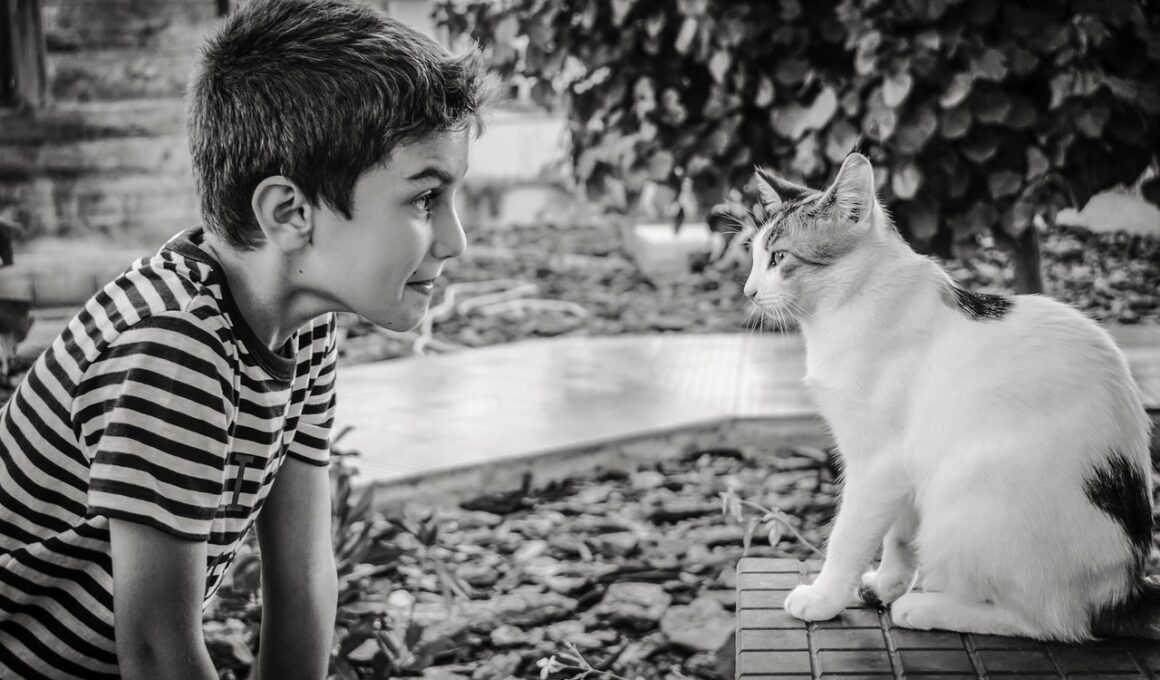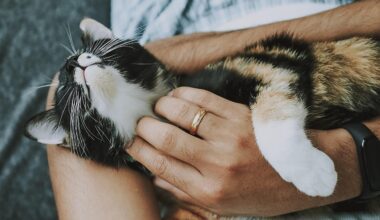How Cats Communicate with Their Owners
Understanding how cats communicate with their human companions can be a fascinating exploration. Cats utilize a combination of vocalizations, body language, and behaviors to convey their needs and emotions. For instance, a cat might meow to request food, attention, or playtime, showcasing its unique personality through these sounds. Other than vocalizations, body posture plays a crucial role in communication. When a cat approaches with a straight posture and tail held high, it often denotes confidence and friendliness. Understanding each gesture is important for building a stronger bond. Communication also varies from one cat to another, adding complexity to this relationship. Some might be more vocal, while others remain quiet yet expressive through their actions. It’s key for owners to observe and interpret these signals to better respond to their feline friends. Moreover, various breeds have distinctive attributes, influencing their communication methods. Finally, understanding cat communication can lead to improved dynamics between owners and their beloved pets, emphasizing the essential role of attentive observation in establishing effective interaction.
One of the most visible forms of communication is a cat’s tail position. A raised tail often indicates happiness and confidence, while a low or puffed-up tail may suggest fear or aggression. Additionally, cats knead with their paws as a sign of comfort and affection. This behavior, often witnessed during relaxation, represents a fondness for their owners, reminiscent of kittenhood when they kneaded their mother’s belly for milk. Understanding these gestures can significantly enhance the human-cat relationship. Moreover, facial expressions carry meaning; slow blinking serves as a friendly gesture, a kind of cat smile that indicates trust. Owners can reciprocate by slowly blinking back, signaling a sense of safety and love. Furthermore, cats also communicate through scent marking, which reveals their territory to fellow felines. Cats possess scent glands on various body parts, and rubbing against objects or their owners transfers their scent, strengthening emotional connections. Besides, the purring sound is often misinterpreted. While it frequently denotes contentment, it can also signal discomfort or pain, emphasizing the need to observe context. The interplay of these behaviors presents a rich tapestry of feline communication.
The Role of Vocalizations
Vocalizations create an essential aspect of feline communication, encompassing a range of sounds that convey various emotions and needs. The most common sound, meowing, is often directed specifically towards humans, unlike their interactions with other cats, which rarely involve vocalization. When a cat meows, it may be initiating communication for food, attention, or to make its presence known. Additionally, frequency and intonation are crucial; a high-pitched meow may express displeasure or urgency, while a softer, more drawn-out meow is likely a friendly greeting. Understanding the nuances in sounds is vital for effective response from the owner. Furthermore, cats may hiss or growl when feeling threatened or provoked, serving as a warning sign to other animals or humans. Recognizing these distress calls enables owners to intervene promptly in potential conflicts, ensuring safety for both the pet and people involved. Beyond the typical vocalizations, cats can also chirp or trill, often seen when they expect prey or when they’re excited. This multifaceted vocal behavior showcases the depth of feline communication, enriching the bond between cat and owner.
Body language, complementing vocalizations, delivers crucial signals regarding a cat’s mood and intentions. The positioning of a cat’s ears, for instance, can reveal its emotional state. When cat ears are erect and pointed forward, it signifies curiosity and engagement. Conversely, ears flattened against the head often indicate fear, aggression, or discomfort. By observing these subtle cues, owners can better understand when to approach or give their cat space. Similarly, the body’s posture contributes to deciphering emotions; a confident cat may walk with a casual stride, while a defensive cat may crouch low, preparing to flee or fight if necessary. Squinty eyes or slow blinks during interaction signify relaxation and trust, establishing a bond between the cat and owner, while dilated pupils can indicate excitement or fear. Grooming behaviors further illustrate a cat’s emotional wellbeing. When cats groom each other or their humans, it serves as a social bonding activity, reflecting trust and affection. Paying close attention to these behaviors allows for better communication, paving the way for an enriched relationship built on understanding and mutual respect.
Understanding Challenging Behaviors
Addressing challenges in feline communication requires patience and insight into cat behavior. Cats sometimes exhibit undesirable behaviors akin to miscommunication, often driven by environmental stressors or health issues. For instance, excessive meowing may be an indicator of anxiety, prompting owners to evaluate their cat’s surroundings for potential triggers. Similarly, sudden aggression may signal distress or fear, highlighting the importance of understanding context rather than simply reacting. When observing behaviors such as litter box issues, it could reflect a deeper emotional or physical concern that must be addressed. Providing a quiet, safe space can often reassure a distressed cat and alleviate anxiety. It’s vital for owners to maintain consistent routines and environments, allowing for predictable patterns that create a sense of stability for their cats. Enrichment activities, such as interactive toys, climbing structures, and outdoor exploration, can also help alleviate boredom-induced behaviors. Encouraging play and exploring natural instincts can lead to improved communication and a happier cat. Each of these strategies plays a crucial role in fostering healthy and effective communication, enhancing the owner’s understanding of their feline companions.
Throughout the journey of understanding cat behavior, it’s essential to acknowledge the individuality of each feline companion. Just like humans, cats possess unique personalities that shape their communication styles. While some may be more expressive and vocal, others might be reserved yet communicate through subtle actions and cues. Embracing these differences enhances the pet-owner relationship, allowing for a tailored approach in addressing their needs. Engaging in interactive activities, such as training sessions or scheduled playtime, can also improve cats’ communication skills. Positive reinforcement during training can enhance their willingness to express themselves both verbally and through actions. It’s also crucial for owners to ensure their cats feel secure and unthreatened during interactions. Building trust may take time, but it ultimately leads to a more fulfilling bond. By cultivating an environment rooted in love, stability, and sensitivity to their mood, owners can cultivate a deeper understanding of their cats’ needs. Every interaction provides an opportunity to learn and communicate better, ensuring a harmonious coexistence between cats and their human companions.
Building a Stronger Bond with Your Cat
Establishing and nurturing a strong bond with your cat requires attentiveness and respect for their communication style. Observing and responding to cues helps the cat feel understood and secure. Simple practices can enhance this bond significantly, creating more meaningful moments. For example, spend quality time engaging with your cat through play or grooming. These activities not only build trust but also reinforce positive associations with human interaction. Moreover, creating a cat-friendly environment filled with climbing spaces, comfortable resting areas, and engaging toys can foster well-being, easing communication between you and your furry friend. Additionally, providing opportunities for mental stimulation through puzzle toys or training exercises encourages cats to express their needs and build confidence. Remember that patience is key; forming strong connections takes time. Sometimes, allowing a cat to approach at their own pace ensures they feel in control and safe during interactions. Ultimately, the goal is to create a loving, open environment where your cat feels comfortable expressing themselves fully. This approach not only enhances communication but also enriches the overall experience of cat ownership.


